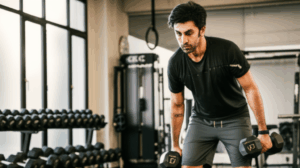In today’s fitness landscape, pushing harder and faster is often glorified. However, a significant shift is underway: recovery is taking center stage. What was once an afterthought is now being recognized as a crucial component of any effective fitness regimen. But how did recovery become the fitness world’s biggest flex? Let’s explore this transformation and understand why prioritizing rest and recuperation is essential for sustained performance, injury prevention, and overall well-being.
The Rise of Recovery
For decades, the fitness industry emphasized relentless training, often overlooking the importance of rest. Many athletes and fitness enthusiasts treated rest days as a sign of weakness, believing that constant exertion was the only path to progress. This mindset often led to overtraining, burnout, and injuries, hindering long-term gains. However, as our understanding of exercise physiology and sports science has evolved, so too has our appreciation for recovery.
Today, recovery is not just about taking a break; it’s an active and strategic process. It involves a combination of techniques and practices designed to repair and rebuild the body after intense physical activity. This includes adequate sleep, proper nutrition, active recovery exercises, stretching, massage therapy, and even advanced technologies like red light therapy and wearable fitness trackers.
Why Recovery Matters
Recovery is essential for several reasons. It allows the body to repair muscle tissue, replenish energy stores, and reduce inflammation. Without adequate recovery, the body cannot adapt to the stress of training, leading to decreased performance, increased risk of injury, and chronic fatigue.
Muscle Repair and Growth: Intense workouts create microscopic tears in muscle fibers. During recovery, the body repairs these tears, making the muscles stronger and more resilient. This process, known as muscle protein synthesis, is crucial for muscle growth and strength gains.
Energy Restoration: Exercise depletes the body’s glycogen stores, which are the primary source of energy during physical activity. Recovery allows the body to replenish these stores, ensuring that you have enough fuel for your next workout.
Injury Prevention: Overtraining can lead to fatigue and muscle imbalances, making you more susceptible to injuries such as strains, sprains, and stress fractures. Rest days give your body the time it needs to recover and repair, reducing the likelihood of injuries.
Performance Enhancement: Recovery is not just about avoiding negative outcomes; it can also enhance performance. By allowing the body to fully recover, you can train at a higher intensity and frequency, leading to better results.
The “Flex” Factor: Why Recovery is Trendy
So, why has recovery become such a popular topic in the fitness world? Several factors contribute to this trend:
1. Increased Awareness and Education
Thanks to advancements in sports science and increased accessibility to information, people are now more aware of the benefits of recovery. Fitness professionals, coaches, and influencers are emphasizing the importance of rest and recuperation, dispelling the myth that “more is always better.” This increased awareness has led to a greater demand for recovery-focused products and services.
2. The Rise of Wearable Technology
Wearable devices like smartwatches and fitness trackers have made it easier than ever to monitor various metrics related to recovery, such as sleep quality, heart rate variability (HRV), and muscle fatigue. This data allows individuals to personalize their recovery strategies and optimize their training schedules. The ability to track and analyze recovery metrics has made it a more tangible and measurable aspect of fitness.
3. The Influence of Social Media
Social media platforms have played a significant role in popularizing the concept of recovery. Fitness influencers and celebrities often share their recovery routines, showcasing practices like yoga, meditation, massage, and cryotherapy. This exposure has made recovery seem more appealing and accessible to the general public. Additionally, sharing recovery activities on social media can be a way for individuals to demonstrate their commitment to a balanced and healthy lifestyle.
4. The Focus on Longevity and Sustainability
As people become more interested in long-term health and wellness, they are realizing that sustainable fitness practices are essential. This means prioritizing recovery to prevent burnout and injuries, allowing them to stay active and healthy for years to come. The shift towards longevity has made recovery a central component of the fitness conversation.
5. The “Self-Care” Movement
The broader “self-care” movement has also contributed to the rise of recovery. As people become more aware of the importance of mental and emotional well-being, they are seeking out activities that promote relaxation and stress reduction. Recovery practices like meditation, yoga, and massage align perfectly with the principles of self-care, making them even more appealing.
Recovery Techniques: From Basics to High-Tech
The world of recovery encompasses a wide range of techniques, from simple lifestyle adjustments to advanced technological interventions. Here are some of the most popular and effective recovery methods:
1. Sleep
Sleep is arguably the most crucial aspect of recovery. During sleep, the body repairs muscle tissue, replenishes energy stores, and regulates hormones. Aim for 7-9 hours of quality sleep each night to maximize recovery.
- Tips for Better Sleep:
- Establish a consistent sleep schedule.
- Create a relaxing bedtime routine.
- Optimize your sleep environment (dark, quiet, and cool).
- Avoid caffeine and alcohol before bed.
- Consider using sleep-tracking apps or devices to monitor your sleep quality.
2. Nutrition
Proper nutrition is essential for providing the body with the building blocks it needs to repair and rebuild after exercise. Focus on consuming a balanced diet that includes:
Protein: Protein is crucial for muscle repair and growth. Aim to consume 0.8 grams of protein per kilogram of body weight daily, with a focus on consuming protein-rich foods after workouts.
Carbohydrates: Carbohydrates replenish glycogen stores, providing energy for future workouts. Choose complex carbohydrates like whole grains, fruits, and vegetables.
Healthy Fats: Healthy fats support hormone production and reduce inflammation. Include sources like avocados, nuts, seeds, and olive oil in your diet.
Hydration: Dehydration can hinder performance and slow down recovery. Drink plenty of water throughout the day, especially before, during, and after exercise.
3. Active Recovery
Active recovery involves engaging in low-intensity activities to promote blood flow and reduce muscle soreness. Examples include:
- Light Cardio: Walking, cycling, or swimming at a low intensity.
- Yoga: Gentle yoga poses to improve flexibility and reduce muscle tension.
- Stretching: Static or dynamic stretching to increase range of motion and reduce stiffness.
Active recovery helps remove waste products from muscle tissue and delivers nutrients to aid in repair and rebuilding.
4. Stretching and Mobility Work
Stretching and mobility exercises can improve flexibility, reduce muscle soreness, and prevent injuries. Incorporate both static and dynamic stretching into your routine:
- Static Stretching: Holding a stretch for 30-60 seconds to lengthen muscles and improve flexibility.
- Dynamic Stretching: Performing controlled movements through a full range of motion to warm up muscles and improve mobility.
5. Foam Rolling and Massage
Foam rolling and massage are self-myofascial release techniques that can help reduce muscle tension, improve blood flow, and alleviate soreness.
- Foam Rolling: Applying pressure to specific muscles using a foam roller to break down knots and improve circulation.
- Massage Therapy: Professional massage to target deeper muscle tissue and release chronic tension.
6. Cold and Heat Therapy
Cold and heat therapy can be used to reduce inflammation and promote healing.
- Ice Baths: Immersing the body in cold water (50-59°F or 10-15°C) for 10-15 minutes to reduce inflammation and muscle soreness.
- Saunas: Spending time in a sauna to increase blood flow, reduce muscle tension, and promote relaxation.
- Contrast Therapy: Alternating between cold and heat exposure to maximize the benefits of both.
7. Red Light Therapy
Red light therapy involves exposing the body to low levels of red or near-infrared light to reduce inflammation, accelerate healing, and improve muscle function. This technology is becoming increasingly popular in wellness studios and is used by athletes to bounce back quicker from workouts.
8. Compression Gear
Wearing compression garments, such as socks or sleeves, can improve blood flow, reduce muscle soreness, and enhance recovery.
Integrating Recovery into Your Fitness Routine
Making recovery a priority requires a strategic and personalized approach. Here are some tips for integrating recovery into your fitness routine:
- Listen to Your Body: Pay attention to your body’s signals and adjust your training schedule accordingly. If you’re feeling overly fatigued or sore, take a rest day or reduce the intensity of your workouts.
- Plan Rest Days: Schedule rest days into your training plan just as you would schedule workouts. Aim for at least one full rest day per week, and consider incorporating active recovery days as well.
- Prioritize Sleep: Make sleep a non-negotiable part of your routine. Aim for 7-9 hours of quality sleep each night, and create a sleep-friendly environment.
- Fuel Your Body: Consume a balanced diet that supports muscle repair and energy replenishment. Focus on protein, carbohydrates, healthy fats, and hydration.
- Incorporate Active Recovery: Engage in low-intensity activities on your rest days to promote blood flow and reduce muscle soreness.
- Use Recovery Tools: Experiment with different recovery tools and techniques to find what works best for you. This may include foam rolling, massage, cold and heat therapy, or compression gear.
- Track Your Progress: Monitor your recovery metrics using wearable devices or apps to identify trends and optimize your strategies.
- Seek Professional Guidance: Consult with a fitness professional, coach, or healthcare provider to develop a personalized recovery plan that meets your specific needs and goals.
The Future of Recovery
As our understanding of recovery continues to evolve, we can expect to see even more innovative and effective techniques emerge. Advances in technology, such as personalized recovery apps and wearable sensors, will allow individuals to optimize their recovery strategies with greater precision. Additionally, the integration of mental and emotional well-being into the recovery process will become increasingly important.
In the future, recovery will likely be viewed as an integral part of the fitness equation, not just an afterthought. Athletes and fitness enthusiasts will prioritize rest and recuperation as much as they prioritize training, recognizing that both are essential for achieving peak performance and long-term health.
Conclusion
Recovery has indeed become the fitness world’s biggest flex, and for good reason. As we shift away from the “no pain, no gain” mentality, we are beginning to understand the profound benefits of rest and recuperation. By prioritizing recovery, we can enhance performance, prevent injuries, and promote overall well-being. So, embrace the power of recovery and make it a central component of your fitness journey. Your body (and your gains) will thank you.







